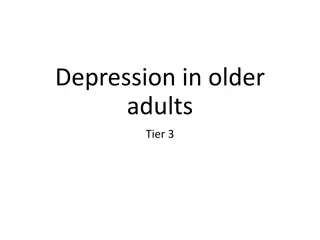Understanding Depression in Older Adults
Depression in older adults is not a normal part of aging and should not be ignored. Recognizing the signs and symptoms, such as disturbed sleep, lack of interest, and thoughts of self-harm, is crucial in detecting and addressing this condition. Presentation of depression may include agitation and personality changes, making it different from typical symptoms. However, depression is often missed in older adults due to various factors, leading to increased risks such as mortality, self-neglect, and cognitive impairment. Seeking help and understanding the potential dangers associated with depression in the elderly is essential for their well-being.
Download Presentation

Please find below an Image/Link to download the presentation.
The content on the website is provided AS IS for your information and personal use only. It may not be sold, licensed, or shared on other websites without obtaining consent from the author. Download presentation by click this link. If you encounter any issues during the download, it is possible that the publisher has removed the file from their server.
E N D
Presentation Transcript
Depression in older adults Tier 1
What is depression? A syndrome- a group of signs and symptoms that occur together and characterise depression . To confirm a diagnosis: The symptoms must be on most days for at least two weeks causing significant social or functional impairment It is NOT a normal experience = NOT inevitable with ageing hence should not be ignored Older adults are less likely to seek help for their mental health problems due to stigma.
Signs and Symptoms of depression Depressed mood with negative thinking Disturbed sleep - Early Morning Wakening Lack of enjoyment and interest Reduced energy levels and lack of motivation Slowness of body and mind Self-esteem and self-confidence are almost always reduced Ideas of guilt or worthlessness are often present Reduced appetite and weight loss loss of libido Thoughts of self harm and suicide
How is presentation different Agitation and restlessness including inability to keep still, constant pacing, irritability Personality changes Preoccupation with physical symptoms Unexplained functional decline (walking /incontinence) Memory problems Minimisation or denial that they have depression
Why is depression missed ? Older person with depression Staff Older adults may not report low mood Staff may not consider the diagnosis and recognition is often low Older adults may not be able to express themselves Staff may believe that depression is justified/ normal Depression is expressed via bodily symptoms Staff may feel ill equipped to deal with the distress Older person may feel ashamed of feeling depressed Staff may be worried about drug side-effects Older adults may not use the term depression Staff may believe depression is untreatable
Risks associated with having depression in older adults Increased mortality in older adults with depression especially from cardio vascular causes Self-neglect Neglect of other physical illnesses Suicide Risk of increased cognitive impairment/ dementia Increased risk of institutionalisation
Assessment History and clinical picture Risk assessment around self neglect /self harm/suicidal thoughts Collateral history Rule out physical health ,medication causes Screening for depression using two questions Assessment scales could be used Becks depression inventory Geriatric Depression Scale Hospital Anxiety and Depression Scale Cornell Scale
Simple questions to screen for depression Two-question screening test During the last month, have you often been bothered by feeling down, depressed or hopeless? During the last month, have you often been bothered by having little interest or pleasure in doing things? Answering yes to either of these questions is considered a positive test result, warranting further assessment.
Management Investigate and treat any biological factors such as some particular illnesses or medication issues Reduce any psychological factors such as difficulties with relationships Reduce any social factors, such as isolation and lack of stimulation Psychological therapies are important hence consider referral to IAPT Medications can also help Refer to Old Age Psychiatry if moderate to severe depression with no response to treatment
Treatment options Treating depression is worthwhile Treatment response is usually good like younger adults Remember antidepressants can be effective but also carry higher risk of side effects because of multiple medical comorbidities and drug-drug interactions in case of polypharmacy. Older adults respond well to psychological therapies
Preventing depression Address any physical health issues early Identify sensory impairments and manage Life story reviews - find time to sit and chat Listen & share-Give genuine time, take an interest Build therapeutic relationships Encourage activities which are enjoyable Encourage exercise if possible Identify depressive symptoms early
Key points to increase detection of depression Think Depression-If you are aware of depression you will be less likely to miss it Be aware of risk factors Look for functional decline Watch for significant symptoms Ask directly about their mood Resources : Depression in Older People-animated video https://www.youtube.com/watch?v=mrqgaLnQ5zQ
Resources Depression in Older People-animated video https://www.youtube.com/watch?v=mrqgaLnQ5zQ MPC_05_06 Where There s Depression, There s Hope | Where There s Depression, There s Hope (mindedforfamilies.org.uk) This is an easy to access website for older adults and their families which has good advice about symptoms and treatment of depression in older adults























